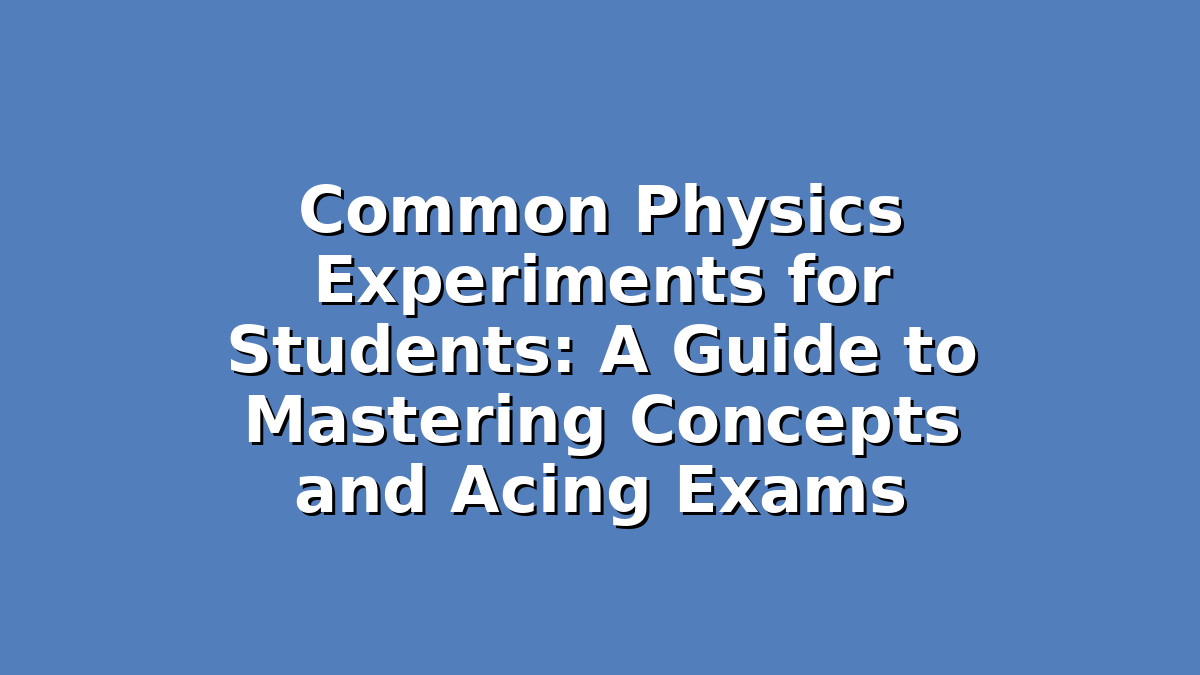Physics can sometimes feel like a challenging subject filled with abstract theories and complex formulas. But the truth is, physics becomes much more understandable—and even enjoyable—when you get hands-on experience. Conducting experiments helps you see theories in action, making concepts clearer and boosting your confidence for exams. Whether you’re preparing for school tests, board exams, or entrance assessments, incorporating practical experiments into your study routine can be a game-changer.
In this article, we’ll explore some common physics experiments that are perfect for students. Alongside each experiment, you’ll find study tips to help you grasp the underlying principles better and prepare effectively for your exams. Let’s dive in!
1. Exploring Mechanics: The Simple Pendulum Experiment
One of the classic physics experiments that every student should try is studying the motion of a simple pendulum. This experiment is excellent for understanding periodic motion, time periods, and the effects of length on oscillation.
How to Perform the Experiment:
– Suspend a small weight (bob) from a fixed point using a string.
– Pull the bob to one side to a small angle and release it without pushing.
– Use a stopwatch to measure the time it takes for the pendulum to complete a certain number of oscillations.
– Calculate the average time period (time for one oscillation) by dividing the total time by the number of oscillations.
– Repeat the experiment by changing the length of the string and observe how the time period changes.
Study Tips:
– Visualize the theory: Before starting, review the formula for the time period of a simple pendulum, T = 2π√(L/g), where L is the length and g is the acceleration due to gravity. Understanding this relationship helps you predict outcomes.
– Record data carefully: Precision in timing and length measurement improves your results and helps you identify any anomalies.
– Graph your results: Plotting length versus time period squared (T²) can reinforce your grasp of the direct mathematical relationship.
– Practice problem-solving: After conducting the experiment, solve related numerical problems to strengthen your conceptual foundation.
This experiment not only clarifies periodic motion but also encourages a methodical approach to scientific inquiry—a skill that serves well in exams and labs alike.
2. Understanding Optics: Investigating the Refraction of Light
Optics is a fascinating branch of physics, and experimenting with light refraction is straightforward and highly instructive. This experiment helps you understand how light bends when passing from one medium to another.
How to Perform the Experiment:
– Take a rectangular glass slab and place it on a sheet of paper.
– Draw the outline of the slab on the paper.
– Shine a ray of light at an angle onto one side of the slab.
– Mark the points where the light enters and exits the slab.
– Use a protractor to measure the angle of incidence and the angle of refraction.
– Repeat for different angles and note your observations.
Study Tips:
– Master the terminology: Make sure you’re clear on terms like angle of incidence, angle of refraction, normal, and refractive index.
– Use Snell’s Law: Practice applying Snell’s Law (n1 sin θ1 = n2 sin θ2) to calculate refractive indices using your measured angles.
– Draw ray diagrams: Visual aids help you understand how light behaves at boundaries.
– Summarize key points: After the experiment, make concise notes on how the refractive index varies and the concept of critical angle and total internal reflection, if applicable.
By repeating this experiment and integrating your observations with theoretical formulas, you’ll develop a solid grasp of light behavior—essential for acing optics questions in exams.
3. Electricity and Magnetism: Measuring Resistance Using a Wheatstone Bridge
Electric circuits form the backbone of many physics curricula, and understanding resistance is crucial. The Wheatstone bridge experiment is a precise method for measuring an unknown resistance and illustrates the principles of balance and circuit design.
How to Perform the Experiment:
– Set up the Wheatstone bridge circuit with known resistors and the unknown resistor.
– Adjust the variable resistor until the galvanometer shows zero deflection, indicating a balanced circuit.
– Use the balance condition to calculate the unknown resistance using the known resistor values.
– Repeat for different resistors to practice.
Study Tips:
– Get familiar with circuit symbols: Being able to draw and interpret circuit diagrams quickly is a big help during exams.
– Understand the balance condition: Knowing how and why the galvanometer shows zero helps you internalize the concept of potential difference and current flow.
– Practice calculations: Work through various Wheatstone bridge problems, including rearranging formulas and solving for unknowns.
– Simulate the experiment: If lab facilities are limited, use online simulators to visualize circuit behavior.
This experiment strengthens your practical understanding of electric circuits and sharpens your problem-solving skills, both critical to mastering electricity topics.
—
Conclusion: Make Experiments Your Study Allies
Physics is not just about memorizing formulas; it’s about understanding how the universe works through observation and experimentation. Conducting these common experiments—simple pendulum, light refraction, and Wheatstone bridge—will deepen your conceptual knowledge and enhance your exam readiness.
To maximize your learning:
– Always review the theory before performing experiments.
– Take neat, organized notes and record your data accurately.
– Use diagrams and graphs to visualize relationships.
– Practice numerical problems related to your experiments.
– Discuss your observations with teachers or classmates to clarify doubts.
Remember, consistent practice and curiosity are your best tools. Embrace experiments as a fun and effective way to conquer physics. With dedication and hands-on learning, you’ll find physics not only easier but also more fascinating. Good luck with your exams!

Responses